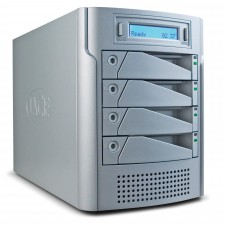Almost everyone who creates digital images has lost crucial information due to some sort of hard drive crash or malfunction. But there’s good news… Memory has become rather cost-effective. Think about how much your first 1G flash card cost compared to your most recent purchase. The same can be said about external hard drives. If you’re in the market for a new external hard drive, here are some hints…
 The very first thing you should look for is an external hard drive with multiple disks, known as a RAID system. A lot of people will buy a single-disk hard drive and partition it. Partitioning a hard drive is when you take a single hard drive and divide it into smaller segments that act as individual hard drives within the primary hard drive.
The very first thing you should look for is an external hard drive with multiple disks, known as a RAID system. A lot of people will buy a single-disk hard drive and partition it. Partitioning a hard drive is when you take a single hard drive and divide it into smaller segments that act as individual hard drives within the primary hard drive.
Partitioning causes a lot of wear and tear on your hard drive, which can also cause it to fail prematurely. Therefore, you should get a hard drive with multiple disks so that there is no need for partitioning. If a hard drive does crash in a RAID system, you simply purchase a new disk and plug it in and it will automatically back up to that disk. It’s safe and it’s easy.
You should also understand exactly how much capacity you’re really getting. Many hard drives list their entire capacity, not what their capacity is if you’re running in a back-up mode. For example, if you want 5 terabytes of storage space you might find a two-disk hard drive that has 5 terabytes of space.
However, once you bring it home and select that you want to run it in safe mode (so that each disk is a copy of the other) you get only half of that storage, or 2.5 terabytes. If you have an external hard drive with two drives, then I would run RAID Mode 0. If your external hard drive contains four drives, then I would run RAID mode 0+1. Both RAID Modes 0 and 0+1 are completely safe, but 0+1 is faster, so you may want to entertain the thought of a four-drive model if speed is important to you.
Another thing you should look for is transfer type and rate. If you can afford it, a hard drive that runs off of an Ethernet connection is going to be best. This is especially useful if you have multiple work stations connected to a central hard drive, or if your files are rather large.
Although I don’t recommend FireWire as a connection to printers, it is recommended for hard drives if Ethernet is not an option. FireWire 800 will usually give a transfer rate up to 100 MB, whereas USB 2.0 will only provide a rate of about 60 MB.
LaCie is a great source for external hard drives, as well as monitors. I would start looking at LaCie’s 2big Quadra or the 4big Quadra. They are robust, safe, and offer storage from 1 TB up to 5 TB. There is one available for every need and price range, starting at around $300.
Off-Site Storage
Just using a good external hard drive will not protect you from other issues like fires, tornadoes, or hurricanes… a Florida favorite. Off-site storage is recommended to protect against such natural disasters.
There are two methods used to handle this… You can pay an off-site company to store your files. They offer insurance and guarantees. I have not used such a service so I cannot give any specific recommendations in this regard.
You can also burn your files onto DVDs and take them off-site. There are two things you need to keep in mind if you are going this route. First, make sure your DVDs are archival. If the DVD can’t stand the test of time, what good is it to use it as backup? Second, store these DVDs in a heavy, fire-proof safe.
Following these steps will guarantee that your precious files are safe, and should allow you to sleep a little more soundly at night.
